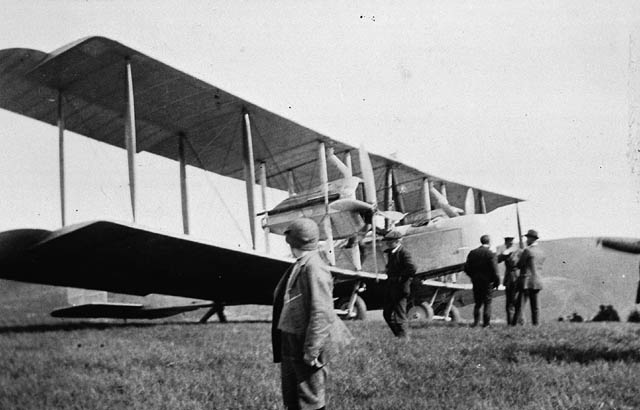Captain John Alcock and Lieutenant Arthur Whitten Brown made the first non-stop aerial crossing of the Atlantic in a modified Vickers Vimy powered by two Rolls-Royce Eagle 360 hp engines. They took off from Lester’s Field, near St. John, Newfoundland on June 14,1919 and landed June 15,1919 at Clifden, Ireland thereby winning the Daily Mail Atlantic Prize and writing their names in the history books.
The rules of the competition were presented in the official notices to members of the Royal Aero Club.
The Proprietors of the Daily Mail have offered the sum of £10,000 to be awarded to the aviator who shall first cross the Atlantic in an areoplane in flight from any point in the United States, Canada, or the Newfoundland to any point in Great Britain or Ireland, in 72 consecutive hours. The flight may be either way across the Atlantic.
-Taken from The Royal Aero Club of the United Kingdom November 21, 1918
The plane had on board a bundles of letters that were entrusted to the fliers by the Postmaster in Newfoundland and these made it to london in record time. The flight covered 1890 nautical miles and sixteen hours of flying .
The journey was not an easy one. While travelling in a fog, the exhaust pipe of the cylinder facing inwards split and the engine shot naked flames into the slip-stream. The batteries in the heading elements of their flying suits ran out and caused the pilots discomfort in the freezing air at 7200 ft. At one point the plane went into a deadly spiral that nearly ended their flight if not for their miraculous last minute regain of control at 65ft. At another, the plane plummeted from 4000 ft to 1000 ft after flying through turbulence. Alcock managed to correct the plane using hs experience as a night bomber.
In London, news was gloomy as all contact with the plane had been lost as the radio broke down soon after takeoff. But the pilots had no time to be gloomy. When ice began to form around the wings and other parts, Alcock had difficulty steering and the engine threatened to quit as snow filled to engine carburetor. But without any de-icing tools onboard, Brown grabbed a knife and did the job himself -crawling from strut to strut.

The pilots sighted land at 8.40. It was not the town of Galvay that they were looking for but the area around Clifden. Alcock brought the plane down on a green meadow that he thought was a safe landing spot but it turned out to be a dangerous swamp. The people in a nearby transmitter building tried to warn them but their waves were understood as a friendly gestures. The men had landed and were unhurt and instantly became heros. They received the price from then Secretary of State for Air, Winston Churchill and they insisted on sharing £2000 with the Vickers and Rolls Royce mechanics.
References:

A wonderful insight of this historic flight … and the way you outlined the dangers they faced as well as the ways in which they overcame them
LikeLike
Thank you for your kind words. It is quite extraordinary that the pilots had to think on their toes for the full duration of the flight. One moment they could be cruising at a steady pace and in the next be fighting for control.
LikeLike
So brave. They knew that if they came down in the sea they would die. No life raft, no distress beacon, no hope of rescue. But they did it anyway.
LikeLike
No question about that. Thanks for reading!
LikeLike
Psst – feel free to delete my email after you see it… but you have a typo in the headline:
transaltanic… been there… done that.
Cheers!
LikeLike
Thanks friend for pointing that out.
LikeLike
No worries, Timothy… we’re in the same aircraft!
LikeLike